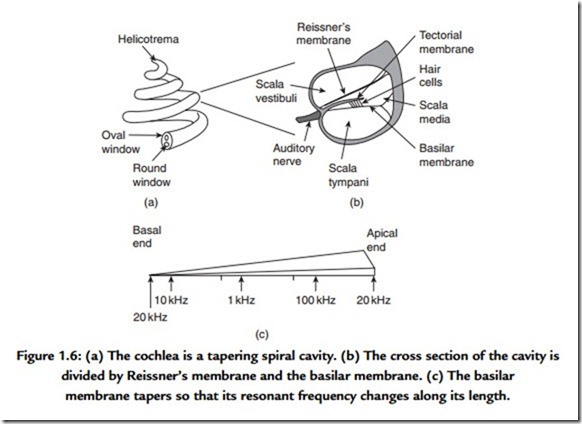The Cochlea
The cochlea, shown in Figure 1.6(a), is a tapering spiral cavity within bony walls, which is filled with fluid. The widest part, near the oval window, is called the base and the distant end is the apex. Figure 1.6(b) shows that the cochlea is divided lengthwise into three volumes by Reissner’s membrane and the basilar membrane. The scala vestibuli and the scala tympani are connected by a small aperture at the apex of the cochlea known as the helicotrema. Vibrations from the stapes are transferred to the oval window and become fluid pressure variations, which are relieved by the flexing of the round window. Essentially the basilar membrane is in series with the fluid motion and is driven by it except at very low frequencies where the fluid flows through the helicotrema, bypassing the basilar membrane.
The vibration of the basilar membrane is sensed by the organ of Corti, which runs along the center of the cochlea. The organ of Corti is active in that it contains elements that can generate vibration as well as sense it. These are connected in a regenerative fashion so that the Q factor, or frequency selectivity of the ear, is higher than it would otherwise be. The deflection of hair cells in the organ of Corti triggers nerve firings and these signals
are conducted to the brain by the auditory nerve. Some of these signals reflect the time domain, particularly during the transients with which most real sounds begin and also at low frequencies. During continuous sounds, the basilar membrane is also capable of performing frequency analysis.
Figure 1.6(c) shows that the basilar membrane is not uniform, but tapers in width and varies in thickness in the opposite sense to the taper of the cochlea. The part of the basilar membrane that resonates as a result of an applied sound is a function of the frequency. High frequencies cause resonance near the oval window, whereas low frequencies cause resonances further away. More precisely, the distance from the apex where the maximum resonance occurs is a logarithmic function of the frequency. Consequently, tones spaced apart in octave steps will excite evenly spaced resonances in the basilar membrane. The prediction of resonance at a particular location on the membrane is called place theory. Essentially the basilar membrane is a mechanical frequency analyzer.
Nerve firings are not a perfect analog of the basilar membrane motion. On continuous tones, a nerve firing appears to occur at a constant phase relationship to the basilar vibration, a phenomenon called phase locking, but firings do not necessarily occur on every cycle. At higher frequencies firings are intermittent, yet each is in the same phase relationship.
The resonant behavior of the basilar membrane is not observed at the lowest audible frequencies below 50 Hz. The pattern of vibration does not appear to change with frequency and it is possible that the frequency is low enough to be measured directly from the rate of nerve firings.
